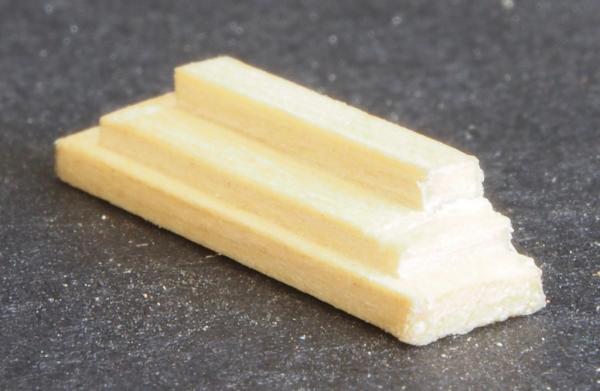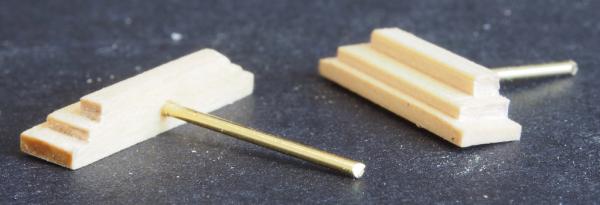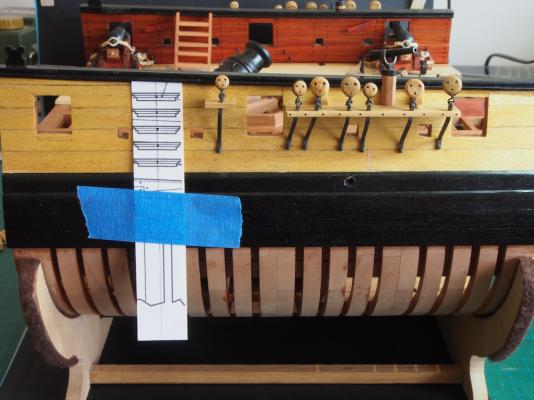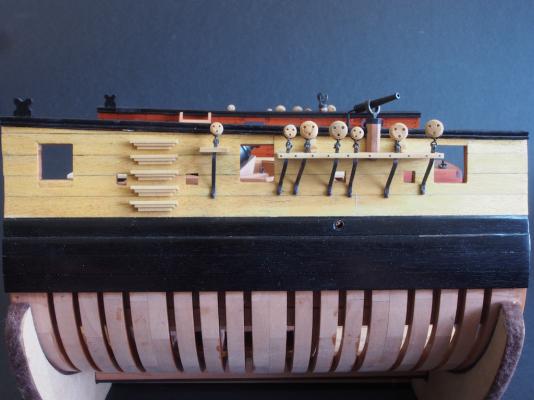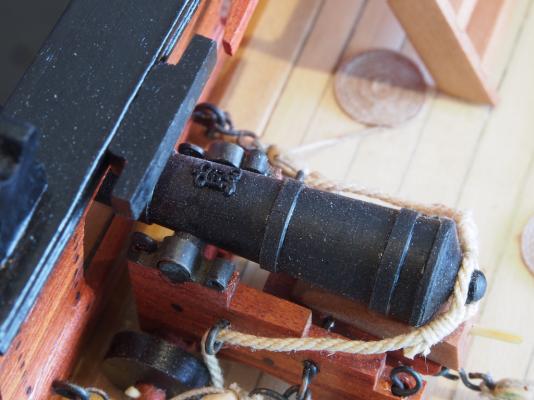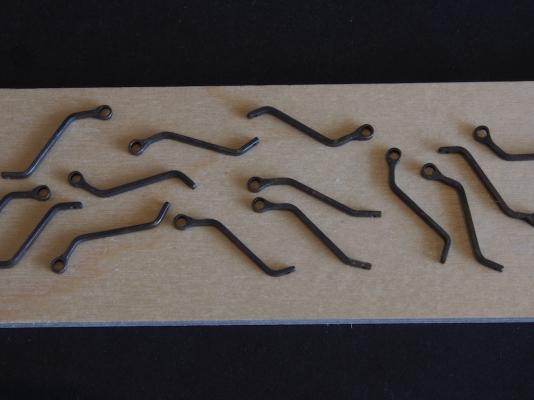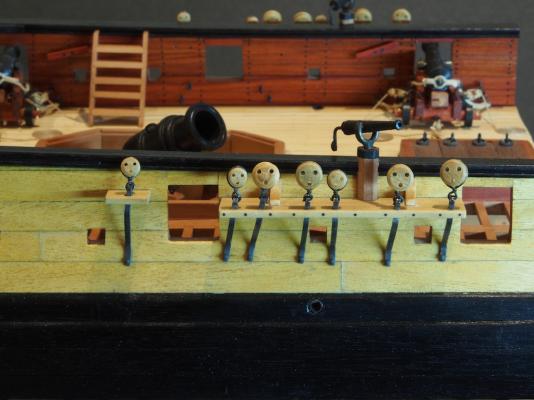-
Posts
4,888 -
Joined
-
Last visited
Content Type
Profiles
Forums
Gallery
Events
Everything posted by gjdale
-
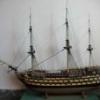
Cutter Cheerful 1806 by rafine - FINISHED
gjdale replied to rafine's topic in - Build logs for subjects built 1801 - 1850
I can thoroughly recommend the Bomb Vessel Cross Section, Bob. The plans by Jeff Staudt are excellent and at 1:48 scale is easy enough to work with while not producing a "monster" to house on completion. I have found it to be a most enjoyable build.- 525 replies
-
- cheerful
- Syren Ship Model Company
-
(and 1 more)
Tagged with:
-

Cutter Cheerful 1806 by rafine - FINISHED
gjdale replied to rafine's topic in - Build logs for subjects built 1801 - 1850
Very nice Bob! Finish line is in sight and approaching quickly. So what IS next?.........- 525 replies
-
- cheerful
- Syren Ship Model Company
-
(and 1 more)
Tagged with:
-
At the risk of repeating everyone else - just WOW! Such ingenious fabrication, and a real joy to follow this.
-
Frustrating - yes. Time-consuming - yes. Valuable learning along the way - absolutely! Good on you for your perseverance Dan. You will be very pleased you bit the bullet at this stage when you see the end result!
-

Blackening brittiana fittings ?
gjdale replied to Senior ole salt's topic in Masting, rigging and sails
Jax Pewter Black will work on Brittania castings. -
Looks like you're off to a good start Phil, and I see you're already receiving plenty of good advice. Just remember to take your time and enjoy the journey. Mistakes will most certainly be a part of the process and re-dos are simply an opportunity to do better. I look forward to following your progress.
-

Cutter Cheerful 1806 by rafine - FINISHED
gjdale replied to rafine's topic in - Build logs for subjects built 1801 - 1850
Congratulations on reaching this milestone Bob. She looks terrific, and that windlass kit from Chuck looks to be well worth the investment.- 525 replies
-
- cheerful
- Syren Ship Model Company
-
(and 1 more)
Tagged with:
-
Another great lesson in machining - thanks Ed!
- 3,618 replies
-
- young america
- clipper
-
(and 1 more)
Tagged with:
-
That's looking really nice Jack. Clearly your painstaking preparations are paying off.
- 170 replies
-
- gokstad
- dusek ship kits
-
(and 1 more)
Tagged with:
-
Thanks again folks for all the kind comments and the "likes" - they really do encourage me to keep striving to do better. The home straight is in sight! Entry Port Ladders The entry port ladders were fairly simple to make – once I used the right timber, and the right method. My first attempt was using 3/16” square stock Yellowheart, and using the Mill to cut the stepped profile. I quickly discovered that while Yellowheart is fine for planking, it is very difficult to use in other applications. It is very coarse grained, and very brittle, meaning that it will splinter as soon as look at you. I also decided that this task would be better accomplished using the Byrnes table saw rather than the mill – quicker, easier, and cleaner. I decided to use Castello Boxwood for the task as it still retained a pale colour to blend in with the external hull planking, and at the same time was consistent with the timber used for the Channels. These two decisions made the task very simple. The profile along the long edge of the ladder steps was cut very quickly onto longer lengths of stock. I decided to add a degree of difficulty by continuing the stepped profile onto the short edge of the steps. The pieces are too small to safely attempt this with the table saw, so they were individually cut using a chisel and finally cleaned up with a file. This last task was also much easier than I had first thought – perhaps I’m starting to develop my skills with the hand tools too! Here is what the steps looked like after profiling: I decided that they would be easier to mount on the hull if they had a locating pin, so I made up a very simple length jig for the drill press to ensure that all steps had a hole exactly in the middle of their lengths, then inserted a long brass pin “handle”. This handle was a useful holding aid while applying a coat of Wipe-on Poly to the non-glued surfaces, after which it was cut off to a more appropriate length. To aid in placing the steps accurately on the hull, a template was printed from the drawings and attached to a piece of card stock. This was taped in place on the hull while the centres of the steps were marked through with a brad point. The locating holes were then completed by very carefully hand drilling, and the steps glued in place. PVA was used for gluing, which gave ample time to ensure that each step was aligned parallel to its neighbour. Also during the week, my shipment of monograms from Chuck’s Syren company arrived – I think mine may have been the very first order placed, or if not, it was very close. I have to say that I am delighted with the product. The larger size is just right for this scale – a side-by-side comparison with the Russian-made (? or perhaps Ukrainian?) guns that Danny had given me previously showed that Chuck’s monograms were pretty much identical in size, and they also match really well against Jeff’s drawings. Well done Chuck! I gave them a coat of Floquil Engine Black prior to cutting from the sprue, and then put a tiny dab of CA glue on the barrels before placing the monograms ever so carefully with a pair of very fine pointed tweezers. This job would of course have been much easier to do prior to mounting the guns. Anyway, here’s a couple of shots showing the monograms in place on both the Mortar and Gun barrels. Unfortunately, the photos also show just how badly the model needs cleaning up prior to completion. I have been working on the "optional" Mortar Pit Housing over the last couple of days. Not sure if I will complete this yet or not for two reasons. Firstly, as I have been doing this, I have discovered that the recesses I cut into the top of the Mortar Pit are not actually the right size - I didn't appreciate at the time how everything worked together, so I went with something that looked "about right" at the time. If I had studied the plans more thoroughly, I might have realised this and been in good shape at this point. The other reason is that as far as display goes, it really needs for the Housing to be completely on or completely off - there doesn't seem to be a 50/50 option. So, I may just continue to make the parts for the heck of it, or I may get to the point where I simply call "done". I ordered the display case this week, so I've got until that arrives to finish this task, make the final display cradle/stand, and apply some Wipe-on Poly finish to the external lower hull. Oh yes, and clean the pesky dust off !!!!!
- 456 replies
-
- finished
- bomb ketch
-
(and 2 more)
Tagged with:
-
Sorry to hear about the Half Moon, Sjors, but do I recall correctly that Anja has a scratch build Hannah package waiting in the wings? Could be just the excuse needed to start on it!
- 1,616 replies
-
- caldercraft
- agamemnon
-
(and 1 more)
Tagged with:
-
Very clever indeed Nils - they look great!
- 2,625 replies
-
- kaiser wilhelm der grosse
- passenger steamer
-
(and 1 more)
Tagged with:
-
Very nice work Mike. Must have been a bit nerve-wracking the first time you used the plane on it!!!
- 968 replies
-
- hahn
- oliver cromwell
-
(and 1 more)
Tagged with:
-
Congratulations on completing an outstanding model and equally fascinating build log / history lesson, Cathead. I have really enjoyed the journey - thank you for sharing this with us all.
-
Fascinating and educational Druxey - not to mention exquisitely executed!
- 641 replies
-
- greenwich hospital
- barge
-
(and 1 more)
Tagged with:
-
Good choice Mark. I've learned that if you are considering whether or not to do a re-do, then you absolutely need to do it!
-
Thanks again for all the kind comments, thoughtful suggestions, and of course all of the "likes". Chainplates – again! After pondering the problem of the chainplate failure for a few days, and after receiving a few suggestions from my MSW friends, I concluded two things: Firstly, I had been a little too zealous with the clean up of my silver-soldering when I attached the tube to the flat-bar. The result was that the joint had too small an area of bond, and hence a weak joint. After considering alternative approaches, I resolved to give this another crack. So I used exactly the same method as previously described, only this time taking care to leave a fillet of solder on the “shoulders” of the joint. Here is a picture after drilling, bending and blackening. If you look closely you can see the slight thickening at the joint line. The second conclusion I came to was that I was using wire of too great a thickness for the chain strops. I had been attempting to use 0.75mm diameter brass wire for this. After checking with both Mobbsie and Rusty, I decided that 0.5mm diameter would be better suited (Mobbsie successfully used 0.5mm diameter on his build at this scale, and Rusty used 0.78mm diameter for his build in 1:24 scale). The only problem I ran into here was that I was unable to silver solder the joints of the thinner wire. If it’s possible, it’s beyond my current skill set! Instead, I copied the method used by both Mobbise and Rusty on their builds, and that was to twist the wire one complete turn under the deadeyes, and then tuck the ends into the tube section of the chainplate. This at last produced an acceptable result. I secured the bottom ends of the chainplates with small brass nails left over from previous kits various (though I had to shorten them), and then blackened the heads in-situ by painting on Jax Pewter Black, and washing with distilled water afterwards to halt the reaction. This worked very well and did not have any impact on the surrounding timber (which I was careful to avoid). Finally, I used a dab of C/A glue to encourage the deadeyes to “stand up”. Here is the result: All in all, I’m quite happy with the results. All that remains now is to make the external entry ladder, and perhaps the Mortar Pit Housing, as well as the final stand.
- 456 replies
-
- finished
- bomb ketch
-
(and 2 more)
Tagged with:
About us
Modelshipworld - Advancing Ship Modeling through Research
SSL Secured
Your security is important for us so this Website is SSL-Secured
NRG Mailing Address
Nautical Research Guild
237 South Lincoln Street
Westmont IL, 60559-1917
Model Ship World ® and the MSW logo are Registered Trademarks, and belong to the Nautical Research Guild (United States Patent and Trademark Office: No. 6,929,264 & No. 6,929,274, registered Dec. 20, 2022)
Helpful Links
About the NRG
If you enjoy building ship models that are historically accurate as well as beautiful, then The Nautical Research Guild (NRG) is just right for you.
The Guild is a non-profit educational organization whose mission is to “Advance Ship Modeling Through Research”. We provide support to our members in their efforts to raise the quality of their model ships.
The Nautical Research Guild has published our world-renowned quarterly magazine, The Nautical Research Journal, since 1955. The pages of the Journal are full of articles by accomplished ship modelers who show you how they create those exquisite details on their models, and by maritime historians who show you the correct details to build. The Journal is available in both print and digital editions. Go to the NRG web site (www.thenrg.org) to download a complimentary digital copy of the Journal. The NRG also publishes plan sets, books and compilations of back issues of the Journal and the former Ships in Scale and Model Ship Builder magazines.



